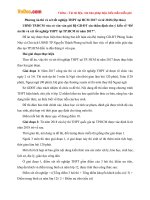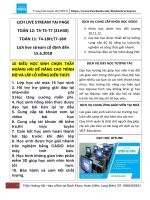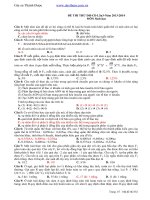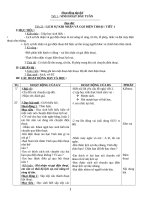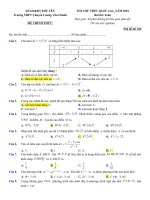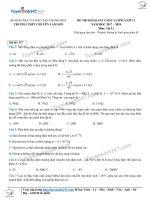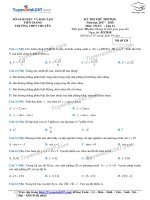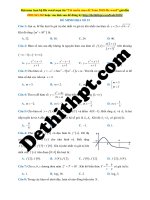Cs224W 2018 23
Bạn đang xem bản rút gọn của tài liệu. Xem và tải ngay bản đầy đủ của tài liệu tại đây (7.15 MB, 12 trang )
Personalized Product Recommendation using Customer Expertise
Stylianos Rousoglou
Victoria Toli
steliosr@ stanford.edu
vtoli@ stanford.edu
MS Computer Science
Stanford ‘20
1. Abstract
In this paper, we develop and experiment with a new approach to product recommendation, in
which customers’ authority relative to specific product categories is quantified and used in
recommendation. Given a particular product category, we define "category experts" to be
customers who have purchased relevant products, left feedback on those products, and whose
comments received positive feedback by others. This way, we are able to discriminate between
customers “seasoned” in particular categories and enhance the process of recommending a ranked
list of products within a given category to a given user. The approach does not require any external
information about users (such as demographics) or specialized product features other than product
category labels; it utilizes co-purchasing information and review metadata.
2. Introduction
Recommender systems play an important role in our daily interactions with computers and other
electronic devices. They are certainly an important tool for businesses who use them daily to
display personalized ads, propose new connections on social media, or suggest new products. The
two common approaches to building a recommender system are user-based and item-based
recommendations, that consider similar users and items respectively (in terms of recorded
preferences) in predicting what a user might also enjoy. However, user-based techniques often rely
on external factors (such as personal and demographic information) that may not be available
depending on the context, or consider all customers equally important.
Our goal is to build a recommender system that given a particular customer and product category,
would return a list of products the customer is likely to purchase and enjoy. To make our approach
context-agnostic, we only rely on simple data that is collected by most all modern online retailers
and
search
services
(e.g.
reviews, and community
spammers.)
Amazon,
Yelp,
etc.),
such
feedback on those reviews
as co-purchasing
(to reward
information,
honest reviewers
customer
and deter
We begin by developing a simple baseline customer similarity algorithm that utilizes copurchasing data. We manipulate the co-purchasing network to develop a Customer-Category, and
subsequently a Customer Network that encodes similarity in tastes between users (both in terms
of liking and disliking similar products). We then develop and tune an “expertise” evaluation
metric to identify the best-scoring customers given a particular customer and product category and
use these “expert” customers to make product recommendations. We use a simple productsimilarity evaluation metric computed on the co-purchasing network to measure how likely the
customer is to enjoy the recommended products of each approach, present our findings, and discuss
possible enhancements and further work that could render our approach more useful.
1 of 12
3. Related Work & Critique
Traditional approaches to data filtering
While the development
of the internet led to a massive increase in online information,
it also
enhanced the difficulty of navigating and searching for information, from a user’s perspective.
Filtering algorithms, on a content or collaborative level, constitute one way to deal with this
problem. The former pertains to recommending objects based on their descriptions. Nevertheless,
description storing is an overwhelming task for an exponentially growing number of objects.
Simultaneously, for users who have selected an insufficient number of object types, this contentbased approach hinders performance.
Alternatively, collaborative filtering consists of two categories: one that examines user-to-user
similarity and one that focuses on item-to-item resemblance. Item-based filtering supposes that
users tend to choose items similar to ones they have already selected, while user-based filtering
assumes that similar users will tend to select similar items.
Although traditional collaborative approaches cover the obvious shortcomings of content-based
methods, they have significant drawbacks, pertaining to sparsity, scalability, and the gray sheep
problem (Ha et al, 2016; Lee et al., 2004; Shi et al., 2014; Su et al, 2009). The issue of sparsity
describes the situation when user-to-user or item-to-item relations are biased: rarely used items are
not reflected in the recommendations. Scalability is problematic when a recommendation system
needs to compute similarity and preference for an enormous set of objects or users. Lastly, the
gray sheep problem refers to the situation when a user’s preferences are atypical or inconsistent
with others’. Those three considerations hamper both performance and ease of implementation.
Recent developments in collaborative filtering
Newer approaches to collaborative recommendation systems have accounted for the
aforementioned limitations. Ha and Lee (2016) proposed an item-network-based collaborative
filtering, which constructs an item network based on users’ item selection history and computes
three types of node centrality: betweenness, closeness, and degree. Nodes’ betweenness is used to
identify significant objects in a user’s item graph. Afterwards, closeness and degree centrality of
those significant nodes give each item a preference score, from each user’s perspective. A
recommendation relies on sorting those preference scores.
An alternative approach utilized user comments in networks where those are available (Wang et
al, 2010). The premise is that comments convey highly reliable information about users’ behavior.
Although this has largely been leveraged in a subset of networks (namely, social media), the
method makes an interesting point: it does not assume that all comments are of equal importance;
it computes an authority index for each user, based on the number of times she has been quoted or
replied to, by employing a variant of the PageRank algorithm (Brin et al, 1998). Yet, is even more
relevant and useful is a general index of user authority, irrespective of whether user comments are
available in a network. Such index will be proposed in the approach section.
2 of 12
4. Dataset
Data format
We are using the Amazon product co-purchasing network metadata dataset,! which consists of
548,552 products, and 7,781,990 user reviews of purchased products, as well as binary feedback
(helpful/not helpful) on those reviews provided by the Amazon community. Each product is given
a unique product ID and assigned a category as well as several subcategory labels. Users are also
given unique IDs that are associated with each review that has been posted.
Data extraction
To be able to work with the data set, significant preprocessing had to be performed. Our data
extraction algorithm returns two structures, one pertaining to customers and one to products. For
the customers data structure, we are mapping customers to products purchased, reviews, and
review feedback:
key: Cust Id, value: {Prod Id: [rating, votes, helpful]} of products purchased
The second data structure that we construct is a product map storing all product information
available, including the title, categories (option differ depending on the group, e.g. Mystery &
Thrillers, Science Fiction, etc. for books), and which customers
review of each product:
have purchased
and written a
key: Prod Id, value: {title, group, categories (set of category Ids), reviews (list of customer Ids)}
However, some products are listed under multiple categories, each of which associated with
multiple subcategories. To simplify such complicated labelling schemes while maintaining a
certain degree of specificity in the description of each product, we only maintained the most
general genre-specific category labels. Labels referring to specific actors, locations, or periods,
were purged for simplicity.
Data reduction
When we started experimenting with graph folding of the multimodal networks we created, it
became evident that our machines lacked the computational power to run algorithm on networks
constructed using the entirety of our dataset. Specifically, by tracking the runtime performance,
we projected that folding the Customer-Category Network into the Customer Network would have
lasted ~ 150 hours and required ~ 70 GB of memory on our 2016 Macbook Pro machines. To
reduce the dataset and run our algorithms successfully, we decided to produce a random sample
of our customers that accounts for ~ 2% of the initial 550,000 or so customers. To maximize our
chances of obtaining meaningful results, we only sampled customer who had purchased at least 3,
and at most 100, products.
/>3 of 12
5. Approach
5.1 Network Construction
Our ultimate goal is to create a hybrid recommendation approach, which combines user similarity
with a model of ascribing higher importance to certain customers given a particular product
category. To do so, we create a simple Customer - Product network; we transform it into a
Customer - Category network; and we finally fold it into a unimodal Customer network.
Customer-Product Network
Customer - Product Graph Degree Distribution
tị
«
Customers
...
Õ
.
°
ủ1
o
"
10-4
range of weights is w € {1,2, 3,4, 5}.
%
Products
fraction of nodes
The bimodal Customer-Product network we
constructed consists of customer and product
nodes. Each customer is connected to each
product they have purchased. Nevertheless, we
believe that liking or disliking a product
purchased are both important in understanding
customer tastes and predicting preferences.
Since snap does not facilitate edge weight
storage, we stored the ratings as values in a
customer-product weight map. As such, the
4
10-5
10°
10!
102
degree
Figure 1: C-P Network Unweighted Degree Distribution
Customer-Category Network
fraction of nodes
To transform the Customer-Product to a bimodal Customer-Category network, we contract all
product nodes of a specific category into a
‘
Customer - Category Graph Degree Distribution
single super node; the weight of the edge
10~
between given customer and a category super
node is equal to the average weight of edges
between the customer and purchased products
10~2 3
°
of said category. If a product belongs in
multiple categories, e.g. a book is labelled both
Mystery & Thrillers and Science Fiction, an
edge is added between each customer who
purchased it and both (book - Mystery &
Customers
Thrillers) and (book, Science Fiction) category
«
Categories
nodes. We once again maintain weights in a
10-4
10°
101
102
103
104
map; the weight between customers 1 and
degree
category j are computed using the formula:
10-3
4
Figure 2: C-C Network Unweighted Degree Distribution
1
”
5Xx|NcpŒ,p]p
€ D1
eet ay
k
and p€ j
4 of 12
Le. the normalized average weight between customer i and products that belong to product
category j in the original Customer-Product graph. As such, the range of weights is w € [0,1].
Customer Network
Finally, the Customer Network is generated as a
unimodal projection of the Customer - Category
Network. Specifically, user nodes in the CC Net
10713
are then
pair of
fraction of nodes
become nodes in the C Net. Edges
constructed as follows: for each
customers, we find all common neighbors in the
CC
Net
(which
correspond
to
product
categories.) For each of those categories, if the
weights between the users and the category node
©
4
10°
e
.s
08
T9
°
8
ett
cee
oo
...5e
CỤ
Sưu
e
i*
Te
©,
:
2 PS
ya," |
oe oo me ‘2 ©
a anawpammmese
ee
cove °° 990 On GHEE
000 0 0 meee CỤ: ©+4020H)0GEGP-ĐU9000m9000D0092©
10)
doves
uP
am
the Figure 3: C Network Unweighted Degree Distribution
the
the weights to rescale them in the range w[0, 1]. The
C Net is computer as follows:
1
I Nec
4
*
10-4
consider the customers’ tastes in the particular
Wij =
10-2
10-3
in CC Net are both above, or both below, a liking
and a disliking threshold, respectively, we
category similar and add +1 weight between
customer nodes in C Net. After repeating
process for all customer pairs, we normalize
weight between two customers i and j in the
Customer Network Degree Distribution
10°
»
NecG)! car encen Nect)
I(cat, i,j)
i.e. where I(c, i,j) an indicator function such that:
I(cat, i,j) =
1 if Wcc (i, cat) = 0.7 and wecGV, cat) = 0.7
}1 if wec(i, cat) < 0.3 and wec(j, cat) < 0.3
0 otherwise
As such, the range of weights is w € [0, 1]. We proceeded to purging edges with weights less that
0.5, as they would make similarity computation unnecessarily more time-consuming. The runtime
of constructing the Customer Network is O(|Cust|?|Cat|), which is the main obstacle we
encountered when attempting to construct a Customer Network using the entire dataset.
Summary of Networks
Nodes
Edges
Customers
Products
Categories
Av. Clust. Coeff.
CP Net
47,021
75,407
9,057
37,964
CC Net
C Net
9,141
44,040
9,057
-
84
9,057
8,995,947
9,057
-
-
0.76
5 of 12
5.2 Approaches to Ranking Customers
Baseline User Similarity
To compute user similarity, we implemented a slightly modified version of the Jaccard measure
of similarity. For customers i and j, and neighbor sets N(i) and N(j), the similarity is computed
by the following formula:
jG,j) =< N@ONO _
:
INŒ)UN@)|[
IN@) n NỢ)|
|NGŒ)| + |N@)| — |NG) n NÓ)|
In our method, for a given pair of users i and j, the Jaccard Index was computed twice on the
Customer-Product Graph: first, Niixeq(), MixeqV) contain the products users i and j actually
liked, defined by a user rating above a predefined liking-threshold. This way, similarity is not
merely defined on the basis of jointly purchased products, but jointly enjoyed products, which we
find to be a more representative indicator of similarity. In the second case, Ngistixeg(t) ,
Naislikea J) contain the products user i and j disliked, defined by a user rating below a predefined
disliking-threshold. Despite the fact that we believe there is significance in users commonly
disliking a product, we decide to give commonly enjoyed products a higher importance. Thus, the
final Jaccard user similarity was computed as follows:
IGD
= 2X Iixealid + JaistixreaJ)
To recommend products using this similarity definition, we first identify (10) customers j with the
highest J (i, j). From those customers’ purchased items, we recommend products of the requested
category that have received the highest ratings by the same customers. Hence, this standard
approach offers (10) product suggestions, leveraging user similarity and product ratings.
Customer Expertise
Our contribution to the Product Recommendation literature is a more expressive similarity index
between users which, while accounting for multiple factors, does not require any user information
other than that available in a Co-Purchasing dataset. After developing such an index, we are
interested in exploring how Customer Experts can be found given a query from customer i for
products in category k, and used to make a personalized recommendation to customer 1.
The factors accounted for were decided empirically and added incrementally to the Customer
Expertise, in order to account for a multitude of parameters computable using the Co-Purchasing
Net alone (See 6.1 for results). First, weights between customer i and neighboring customers in
the C Net are a measure of common interests between the users, which is relevant in looking at
other customers to recommend products from. The “experience” of each customer j in product
category k, as measured by the fraction of products customer j purchased in category k relative to
all the products they purchased, is also relevant, since users who have purchased many products
in category k can generally rate and compare such products more effectively. To discriminate
against fake reviews and spam, the “helpfulness” of customer’s reviews, as measured by the
fraction of “helpful”
votes
to total feedback
votes,
also had to be accounted
for. Finally, to
discriminate between experienced and new users, the total number of purchases and reviews is
accounted for as a fraction of a customer’s purchases relative to all purchases.
6 of 12
In summary, the factors settled upon are:
1.
2.
3.
4.
The commonality of interests between customer i (querying customer) and all other
customers, as measured by the weights between users in the C Net (see Section 5.1)
The fraction of products purchased by each customer j in product category k
The “helpfulness” of customers’ reviews as measured by feedback from other users
The relative total number of products each customer j has purchased and reviewed.
For each customer j, the “expert” score given querying customer i and product category k is
computed as follows:
E„() \ =weuu(,j)ca X~”NepỢ)nNT{allp
€ k}
1
helpƒulQ,p)
“(R01
~¿ "torai0x)
) x IRNep()l)
CP
where Wcwner the edge weight in the C Net, helpful(j, p) the number of “helpful” feedback votes
on customer j’s review of product p, total(j, p) the total feedback votes on that same review, and
Ecp the edges in the CP Net.
To recommend products using this similarity definition, we first identify (10) experts 7 with the
highest £; (7). From those customers’ purchased items, we recommend products of the requested
category that have received the highest ratings by the experts.s
6. Experiments & Results
6.1 Recommending Experts
Table 1 represents a sample run of the expertise computation algorithm for customer Id = 118
and product category “Comedy DVD”, presenting some empirical evidence for the necessity of
incorporating multiple factos in computing expertise. The IDs of the experts are shown, along with
the expertise score and the values of the various factors taken into account by the final expertise
model.
Column 1 presents the experts returned when only factor 1 (commonality of interests) is
considered. Although customer 18 seems to have liked (and disliked) categories similarly (as all
experts on Table | have, as reflected by their common the 1.0 score in factor 1), it’s worth noticing
that customer 18, who is returned as the highest-scoring expert in Column 1, has only made 3
purchases in total. In contrast, Expert #2 has 44 recorded purchases.
Column 2 presents experts returned when factors 1, 2, and 4 are considered in the computation.
Customer 18 is now ranked #4, while all other experts are different, and have purchased more
products in total. However, we notice that for Expert #1, customer 2299, only 0.28 of community
feedback consider their reviews “helpful”. Such significantly low percentage signifies that
customer 2299 may be a spammer, a paid reviewer, or simply a low information content reviewer;
using him to recommend products is not desirable. Column 3 present the results of the ultimate
expertise model. Although the experts returned have not purchased as many products in the
category of interest relative to their total purchases as experts in Column 2 have, they have a
7 of 12
“helpfulness” fraction of at least 0.8; also, they have all purchased at least 6 products, a standard
that 2 out of 5 experts in Column | fail to meet.
“Expertise” factors
1
Expert 1:
18
Score:
Info:
23
Score:
Info:
Expert 3:
Score:
Info:
Expert 4:
Score:
Info:
Expert 5:
Score:
Info:
1,2,3,4
9.78
[1.0, 0.55, 0.28, 11]
9.36
[1.0, 0.67, 1.0, 6]
2299
7.21
[1.0, 0.66, 0.4, 3]
Expert 2:
1,2,4
4405
171
7.21
[1.0, .023, 1.0, 44]
44
7.21
[1.0, 0.17, 0.67, 6]
86
7.21
[1.0, 0.15, 1.0, 13]
106
7.21
[1.0, 0.25, 1.0,4]
3934
9.43
8.57
[1.0, 0.71, 0.87, 7]
[1.0, 0.57, 1.0, 7]
6817
1474
9.36
8.50
[1.0, 0.67, 0.3,6] _ [1.0, 0.48, 0.8, 21]
6.67
[1.0, 0.67, 0.4, 3]
101
4.56
[1.0, 0.27, 0.86, 11]
8.17
[1.0, 0.71, 0.87, 7]
5508
8.15
[1.0, 0.45, 1.0, 11]
Table 1: Top 5 Experts for user Id 118, product category 'DVD' + 'Comedy’, using factor 1, factors 1,2,4, and factors 1,2,3,4,
respectively (see 5.2)
6.2 Recommending Products
To quantitatively evaluate the products returned against a simple baseline, we use a productsimilarity metric derived from the Co-Purchasing network (CP Net). Specifically, we used cosine
similarity to quantify the degree to which 2 products were equally liked (or disliked) by customers
who purchased them both. As such, this similarity metric doesn’t measure intrinsic similarity of
the products, but customer rating correlation between the two. Formally,
S(œ,p,) =
1?
—
Àx¡ eNcp(0+)nNep(0›)fị (4)— X Tị (2)
| Di eNcr@sNce(P2)%
(1)?
x | di ENcp(D1)NcP(P2) Tị
(2)?
where 7 the rating assigned by customer i to product 1. It’s important to note that the above
similarity matric is evaluated on the entirety of the co-purchasing network (100% of the data)
instead of the sample used in building networks, to allow for maximal expressivity of the metric.
Now consider two lists of products, 77, and 712, We define average similarity of those two lists as:
1
Say (11,712) = mIximi
»
»
"
S(i,j)
1 Em, j EM
Let us now examine an example of what product recommendations the customer similarity and
customer expertise-centered approaches might generate. The following table presents the results
returned by each approach, along with a list actual customer purchases, by customer 118.
8 of 12
ID: 118
Purchased products | Baseline recommendations | Expertise recommendations
(Tp)
(Tp)
(Te)
The Big Chill
Anywhere But Here
Santa Claus the Movie (Full Screen Edition)
The
Knights
Hollywood | Vampire's Kiss
But I'm a Cheerleader
Somewhere in Time
Haiku Tunnel
Harold and Maude
Mystic Pizza
The Mexican
Almost Famous
The Big Chill (15th|
Anniversary Edition)
Holy Smoke!
Bruce Campbell vs. Army Of Darkness - The
Director's Cut (Official Bootleg Edition)
The Great Outdoors
Say It Isn't So
Almost Famous
Untitled - The Bootleg Cut
(Director's Edition
Rivethead: Tales from
the Assembly Line
An Everlasting Piece
Army of Darkness
The Wild One
The World According to Garp
Army of Darkness (Boomstick Edition)
Somewhere
in
Time
(Collector's Edition)
Jackass
Galaxy Quest - DTS
-
The
Movie
Screen Special Edition)
Say (mp, Ty)
(Full
Sav(p,Trạ) = 0.644
= 0.459
Table 2: Recommendations of baseline algorithm and experts algorithm for customer 118, category "Comedy DVD"
In order to explore how much better the expert recommendations might perform against our
baseline customer similarity recommendations, we ran both algorithms on a sample of 2,000
random
customer — category combinations,
obtained Syy(p,2»), Sav(tp, me) results, and
evaluated the average improvement in similarity obtained by using the experts, as well as the
fraction of sample runs that experts recommended more correlated products overall. Results are
summarized in Table 3.
Baseline
Šay (Tp, Tre)
Sav
> ŠAy (Tp, Trp)
Recs.
Expert Recs.
0.572
0.34
Av. Similarity Gain
0.744
0.66
+ 17.2%
Table 3: Summary of results on 2,000 sample
customer / category combinations, and net
similarity gain results. Each run took ~ 1015 seconds, for a total of ~ 7 hours of total
nu
7. Discussion & Limitations
Running both algorithms on 2,000 random customer / category pairs is a sufficient sample to
provide a reasonable overview of the difference in performance between the two approaches
outlines in Section 5. As presented in Table 3, expert recommendations dominated simple
customer similarity recommendations by an average similarity of +0.172. In ~66% of all
sample runs, the expert recommendations performed better. We proceed to discuss the implications
of these results and suggest ways that the model could be enhanced and expanded.
First, we were interested in exploring how the customers querying our algorithm for product
recommendations may themselves affect the results. We noticed that for some customers, expert
9 of 12
recommendations were performing worse than baseline recommendations. After manually
inspecting such examples, we performed sample runs on 1,000 customer / category pairs of two
kinds: customer / category pairs for which customers had already purchased at least 1 product of
the given category; and customer / category pairs for which customers hadn’t. The results
presented in Table 4 indicate a significant disparity between samples of the first and second kind.
Specifically, the expert recommendation worked ~ 22% better in cases where customers had
already purchased one or multiple products of given category.
An indicative example of the problem is shown in Table 5 (See Appendix A), where the list of the
user’s purchased products is highly redundant, and repeated information confers little
improvement to our understanding of the user (i.e. the list includes products that are almost
identical, such as Pride And Prejudice (Scholastic Classics) and Pride and Prejudice (Penguin
Classics)). Hence, for both recommendations, the results have a relatively low similarity to the
purchased items. At the same time, if all products purchased by the customer belong to a single
category, which is inherently vastly different from the requested category, both recommendations
are bound to perform poorly.
Average
products
similarity
to
purchased
Condition 1: user has not purchased any product from the requested groupcategory.
0.589
Condition 2: user has purchased at /east one product from the requested
group-category.
0.813
Table 4: Effect of customer purchases
on the quality of user expertise-centered recommendation
There are several limitations in our approach worth addressing. The main limitation we
encountered throughout all phases of our project was a lack of enough computational resources.
The fact that we needed to reduce our data by ~ 98% (See Section 4) meant limiting the
expressiveness of our model and results; significantly less customer — product data imply less
accurate estimates of customer similarity and customer expertise. Using multiple cores and
parallelizing computation could have sped-up network operations and allowed us to use more data.
For a more rigorous evaluation of the extent of success of using product category experts to
recommend products, we could use an active data collection scheme that would collect feedback
from product recommendations to customers and which could then be used to refine the model. In
simulating such a scheme in this project, one option would have been to use temporal information
of customer purchases to split purchases between training and testing sets; however, that approach
would have limited our training data even more, so we decided to not follow it.
Utilizing user feedback on information content is already widely popular in contexts such as social
media (where the relative amount of mainly positive feedback determines the visibility and
prominence of user-generated content such as Facebook comments or Tweets.) In developing the
customer expertise metric, we wanted to capture the significance of such feedback available in the
Amazon product metadata dataset. Although it’s clear that utilizing expertise score to recommend
products performs well in a significant fraction of queries, a more expressive metric than the binary
“helpful” vs. “not helpful” would likely cater to the development of a more fine-tuned model.
10 of 12
8. Contributions
Stelios:
Abstract
+
Intro,
Customer-Product
Net,
Customer-Category
Net,
Customer
Net,
Expertise (Metric, Experiments & Recommendation), Limitations
Victoria: Abstract + Intro, Related Work, Baseline Customer Similarity (Metric, Experiments &
Recommendation), Product Similarity Metric + Experiments, Limitations
9. Github
All code, helper files and graphs used, are available at github.com/steliosrousoglou/224W.
10. References
Ha, T., & Lee, S. (2017). Item-network-based collaborative filtering: A personalized
recommendation method based on a user’s item network. Information Processing &
Management, 53(5), 1171-1184. />
Jia Wang, Qing Li, Yuanzhu Peter Chen, and Zhangxi Lin. 2010. Recommendation in
Internet forums and blogsZ. Association for Computational Linguistics, Stroudsburg, PA,
USA, 257-265.
Koohi, H., & Kiani, K. (2017). A new method to find neighbor users that improves the
performance of Collaborative Filtering. Expert Systems with Applications, 83, 30-39.
/>
Ma, X., Li, B., & An, Q. (2013). A Network-Based Approach for Collaborative Filtering
Recommendation. In Behavior and Social Computing (pp. 119-128). Springer International
Publishing. />
11
Su, X., & Khoshgoftaar, T. M. (2009). A Survey of Collaborative Filtering Techniques.
Advances in Artificial Intelligence, 2009, 1-19. />U, L., Chai, Y., & Chen, J. (2018). Improved personalized recommendation based on user
attributes clustering and score matrix filling. Computer Standards & Interfaces, 57, 59-67.
/>
11 of 12
Appendix A
User | Purchased
ID: | products
49
Purchased products | Baseline recommendations
Pride and Prejudice | Pride And Prejudice _| Betrocks Guide to Landscape
Pride And
Prejudice
(Scholastic
Classics)
Expertise
Recommendations
Barbie Doll Fashion:
(Everyman's Library) | Palms
1968-1974 (Barbie Doll
Fashion)
Pride and Prejudice
(Dover Thrift
Barbie Fashion, 19591967 (Barbie Doll
Betty Crocker's Cookbook:
Bridal Edition
Editions)
Fashion)
Pride and Prejudice | Pride and Prejudice
Victoria: At Home with White:
(Audio Editions)
Celebrating the Intimate Home
(Bookcassette(r)
Edition)
Pride and Prejudice | Pride and Prejudice
(Penguin Classics) | (Modern Library
Classics)
The Art of Polymer Clay:
Designs and Techniques for
Making Jewelry, Pottery and
The New Cottage Home
The Camerer Cuss Book
of Antique Watches
Decorative Artwork
Pride and
Prejudice, Third
Pride and Prejudice
Scented Geraniums: Knowing,
Growing, and Enjoying Scented
Pelargoniums
Amazing Gracie: A Dog's
(Modern Library)
Pride and Prejudice
(Oxford Illustrated
The Polymer Clay Techniques
Book
Furniture Treasury
Edition (Norton
Critical Editions)
Pride and Prejudice
(Oxford World's
Classics)
Tale (Thorndike Core)
(Furniture Treasury)
Jane Austen)
Sav(mp,
Table 5: Personalized Recommendation
for
Tp)
=
0.420
Say (Tp, Te)
=
0.610
“Home & Garden” Book
12 of 12
